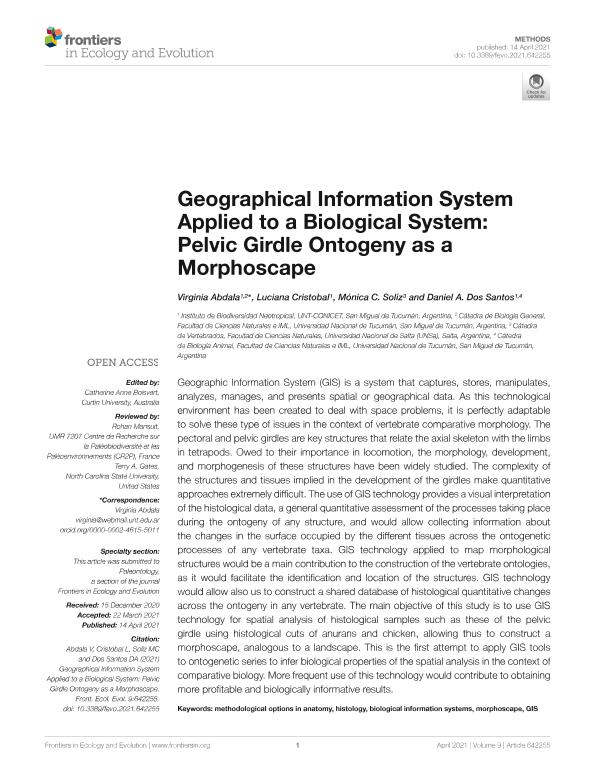Artículo
Geographical Information System Applied to a Biological System: Pelvic Girdle Ontogeny as a Morphoscape
Abdala, Virginia Sara Luz ; Cristobal, Luciana María
; Cristobal, Luciana María ; Soliz, Monica Carina
; Soliz, Monica Carina ; Dos Santos, Daniel Andrés
; Dos Santos, Daniel Andrés
 ; Cristobal, Luciana María
; Cristobal, Luciana María ; Soliz, Monica Carina
; Soliz, Monica Carina ; Dos Santos, Daniel Andrés
; Dos Santos, Daniel Andrés
Fecha de publicación:
14/04/2021
Editorial:
Frontiers Media
Revista:
Frontiers in Ecology and Evolution
ISSN:
2296-701X
Idioma:
Inglés
Tipo de recurso:
Artículo publicado
Clasificación temática:
Resumen
Geographic Information System (GIS) is a system that captures, stores, manipulates, analyzes, manages, and presents spatial or geographical data. As this technological environment has been created to deal with space problems, it is perfectly adaptable to solve these type of issues in the context of vertebrate comparative morphology. The pectoral and pelvic girdles are key structures that relate the axial skeleton with the limbs in tetrapods. Owed to their importance in locomotion, the morphology, development, and morphogenesis of these structures have been widely studied. The complexity of the structures and tissues implied in the development of the girdles make quantitative approaches extremely difficult. The use of GIS technology provides a visual interpretation of the histological data, a general quantitative assessment of the processes taking place during the ontogeny of any structure, and would allow collecting information about the changes in the surface occupied by the different tissues across the ontogenetic processes of any vertebrate taxa. GIS technology applied to map morphological structures would be a main contribution to the construction of the vertebrate ontologies, as it would facilitate the identification and location of the structures. GIS technology would allow also us to construct a shared database of histological quantitative changes across the ontogeny in any vertebrate. The main objective of this study is to use GIS technology for spatial analysis of histological samples such as these of the pelvic girdle using histological cuts of anurans and chicken, allowing thus to construct a morphoscape, analogous to a landscape. This is the first attempt to apply GIS tools to ontogenetic series to infer biological properties of the spatial analysis in the context of comparative biology. More frequent use of this technology would contribute to obtaining more profitable and biologically informative results.
Archivos asociados
Licencia
Identificadores
Colecciones
Articulos(IBN)
Articulos de INSTITUTO DE BIODIVERSIDAD NEOTROPICAL
Articulos de INSTITUTO DE BIODIVERSIDAD NEOTROPICAL
Citación
Abdala, Virginia Sara Luz; Cristobal, Luciana María; Soliz, Monica Carina; Dos Santos, Daniel Andrés; Geographical Information System Applied to a Biological System: Pelvic Girdle Ontogeny as a Morphoscape; Frontiers Media; Frontiers in Ecology and Evolution; 9; 14-4-2021; 1-9
Compartir
Altmétricas



